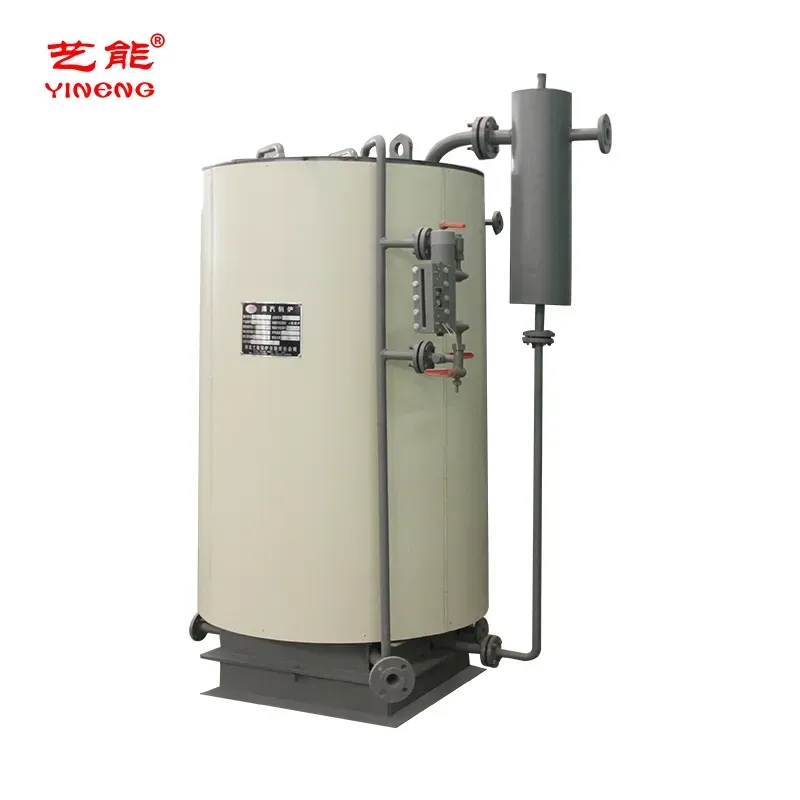By nature, steam boilers are more complex than hot water boilers. With more variables to contend with, like steam pressure and water quality, it is important to understand the various design options along with their advantages and drawbacks in order to select the best boiler for any given application.
Steam Boilers come in a wide variety of configurations, Below some of the most common types are listed:
- Firetube Boiler
Cylindrical pressure vessel with submerged furnace and multi-pass tubes. These boilers are efficient, cost-effective with many proven design variations to meet project-specific requirements. With capacity up to 80,000 pph and pressures up to 350 psig (saturated only), this type of boiler is the most commonly used style for industrial and hospital applications. - Watertube Boiler
With the water inside bent tubes that form the furnace and convection passes, the Watertube design can reach capacities of 500,000 pph and pressures in excess of 1000 psig. These boilers are easily fitted with steam superheater sections, making them natural choices for large industrial or combined heat and power (using steam turbines) applications. - Low Volume Watertube Boiler
A key feature of these types of boilers is that they respond rapidly to a variable steam demand, making them ideal for food and beverage applications or any industrial process where high-grade feedwater and dynamic loads are expected. - High Pressure Steam Boiler
High Pressure Steam Boilers, while not as common as they used to be, are still important for industrial processes that need the higher temperatures associated with elevated steam pressures. They are typically rated for 150 psig or higher and can be firetube or watertube designs, with pressure vessels that are fabricated to handle the added stress and temperatures. The instrumentation, safeties, and controls while similar to low pressure designs, are all designed and rated for the pressure/temperature service encounters. - Low Pressure Steam Boiler
Low Pressure Steam Boilers can take a variety of forms (firetube, watertube, cast iron sectional, firebox, etc) because the pressure vessels are not subjected to the extreme stresses that a high pressure boiler would see. “Low Pressure” generally refers to a boiler that is designed to have a maximum operating pressure below 15 psig. ASME codes define construction methods and materials required for low, (and high) pressure units. Most commonly, low pressure boilers are used for comfort heating, humidification, and for some lower temperature process applications. Safeties and controls are generally similar to those of high pressure units.
Each of the boiler types listed above can be customized with special features and controls that improve their ability to perform in a given application. So, with a wise selection of boiler type and the application appropriate trim and controls, a boiler will be safe, efficient, and reliable. Conversely, poor selections can result in a boiler that is expensive to operate and lasts only a few years – not to mention, dangerous to be around.
Biomass fired reciprocating grate steam boiler
Before choosing a boiler design, it is helpful to understand as much as possible about the steam load and the operation of the steam system. (See applications below). For example:
- Is the load consistent or is it more variable over time, and how fast does it change?
- Will the plant send back all of the condensates or will 100% freshwater be needed to make up for the steam used from the header?
- What steam pressure do I need at my process or heating equipment?
Steam Pressure
Boilers normally operate at a pressure slightly higher than that which is needed so that line losses may be overcome as steam travels through the system. Generally more steam (thermal energy) can be delivered to the heating equipment in higher pressure steam using smaller diameter piping than in low pressure systems. Sometimes high pressure steam is delivered but pressure is then reduced at the point of use via a pressure regulator or back pressure steam turbine.
This highly efficient configuration is known as “Combined Heat and Power” or CHP and can be employed in larger steam systems where the boiler has the ability to generate steam at a much higher pressure than is needed for the process. In this concept high pressure steam is generated using low cost natural gas and then is efficiently converted to electrical power via a backpressure steam turbine generator. The difference in pressure and the steam flow will determine how much power can be generated at the turbine generator. Typical minimums are 10,000 pph steam flow and 100 psig pressure deltas. As the cost of electrical power from the grid increases, the economic viability of these systems will continue to improve. Many industrial clients like the added reliability that onsite power generations brings to a facility.
Typically steam systems are categorized according to pressure requirements and pressure (and psi refers to psi-guage).
- 15 psi or less – limited area heating, humidification, low temperature applications.
- 15 psi – 150 psi – larger facility heating needs, process applications
- Above 150 psi – industrial facility, large campus needs, or processes requiring fluctuating pressure levels
- Superheated Steam– typically over 150 psi, and used in power generation, or to reduce condensate formation in long piping runs.


